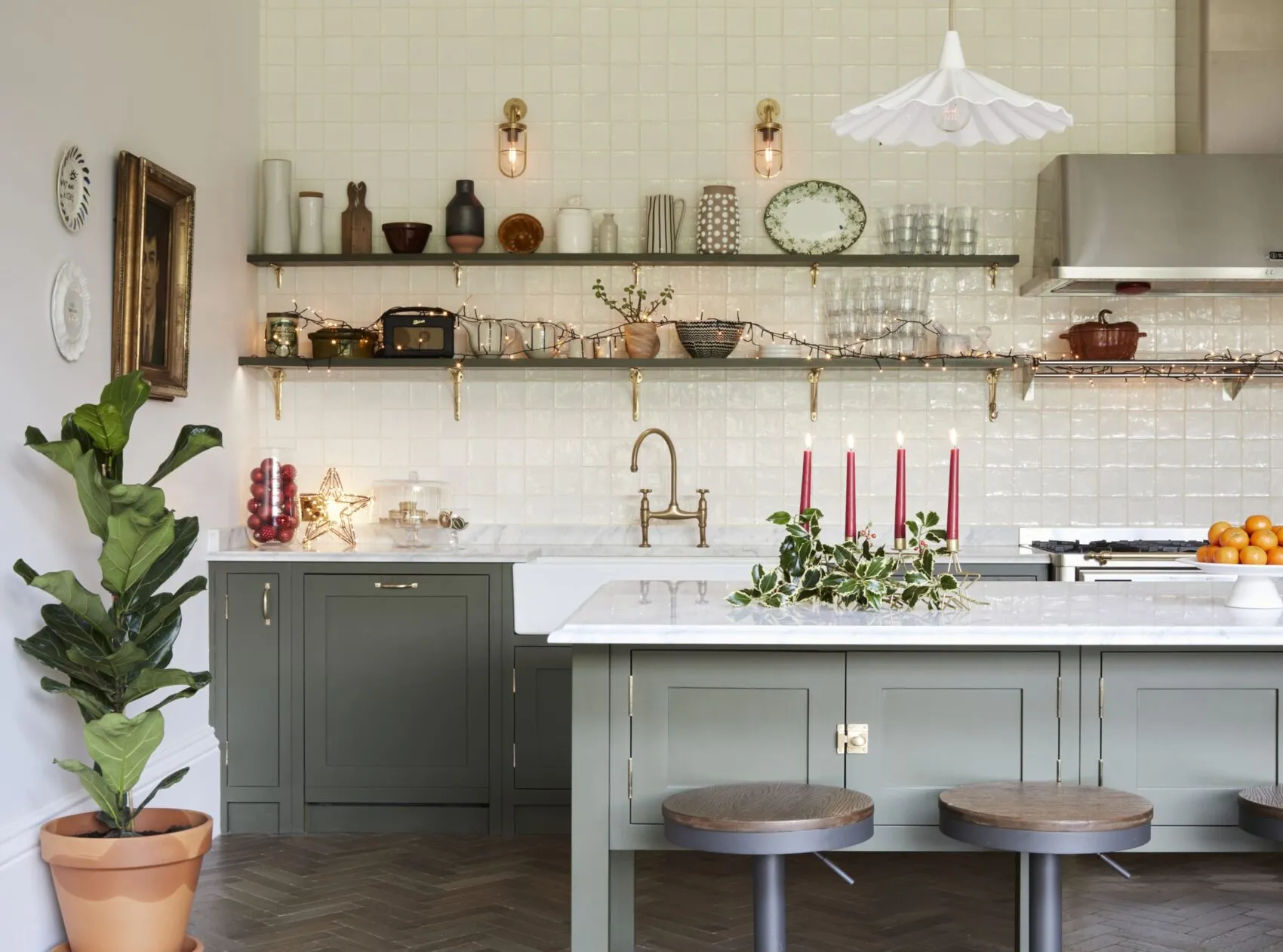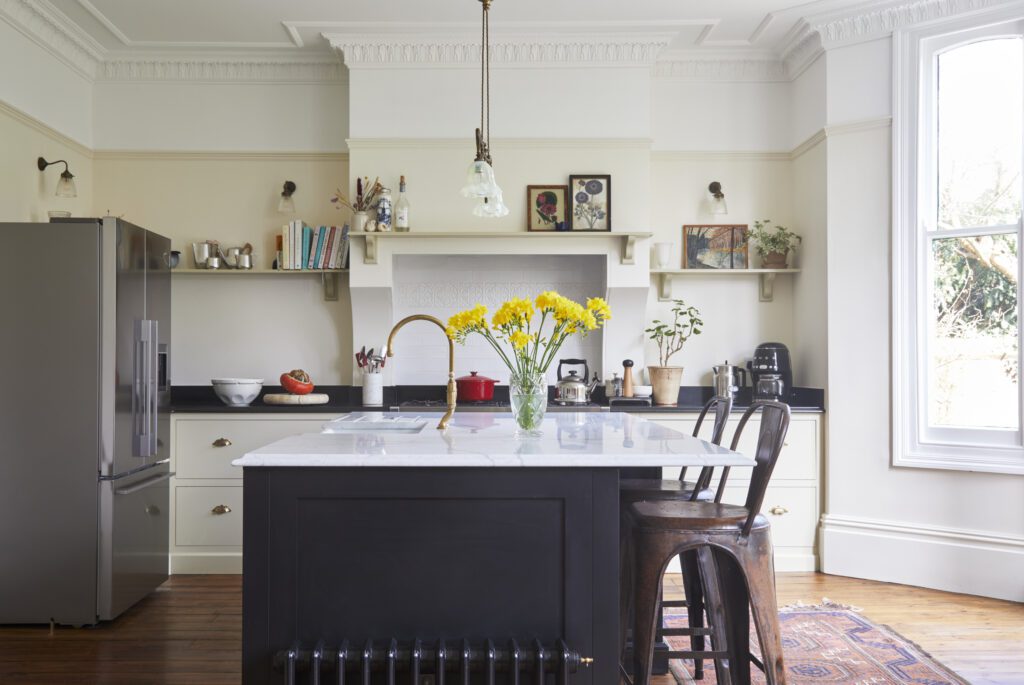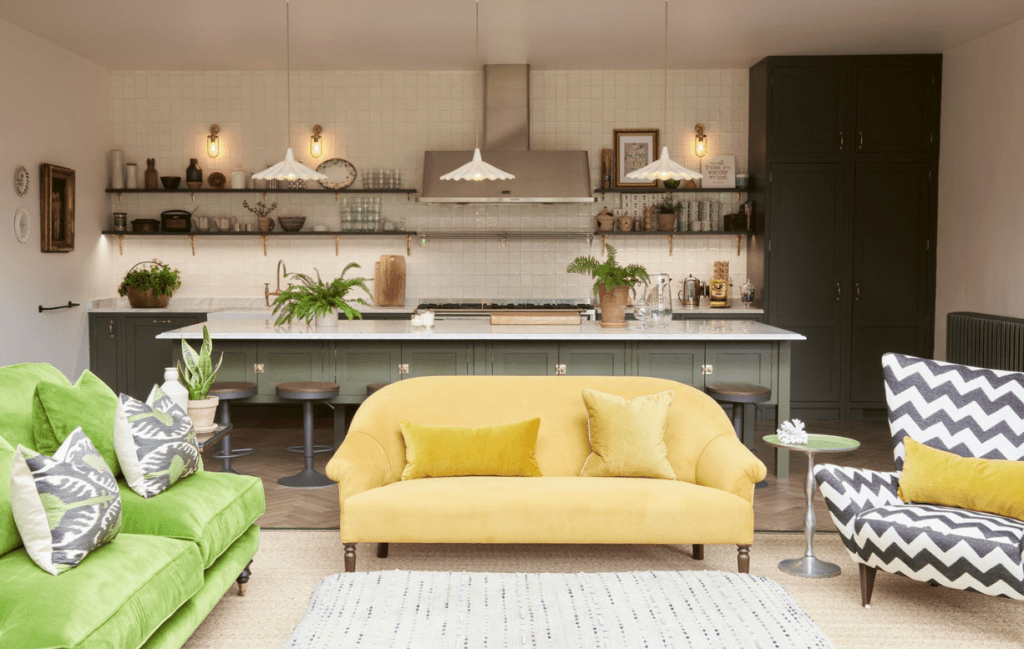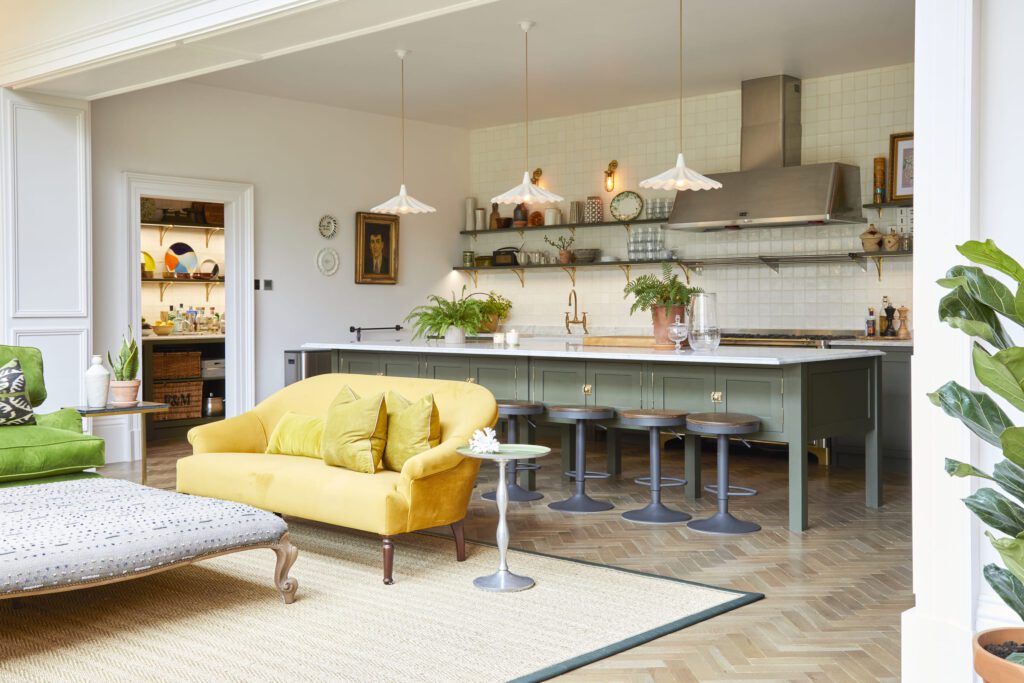
Seize the charm of simplicity with a classic design that stands against the test of time – behold, the Shaker Style Kitchen. As increasingly more homeowners across the UK are looking to add a dash of historical elegance to their cooking spaces, the Shaker style reigns supreme. But what exactly is a shaker-style kitchen, and why is it so enduring in its appeal? Join us as we embark on an enlightening journey to explore this distinctive design choice, pulling back the lid on what makes it blend fantastic functionality with oh-so-captivating aesthetics harmoniously.
A shaker style kitchen refers to a kitchen design that embraces minimalism, clean lines, and functional craftsmanship. It originated from the Shakers religious sect in the 1780s and focuses on simple, timeless elegance with practicality. Shaker kitchens typically feature recessed panel cabinet doors with four-piece wood frames, dovetail joints, light-coloured woods, and modest hardware. They can be incorporated into various design styles and offer versatility in terms of finishing options.
Understanding Shaker Style Kitchen
A Shaker style kitchen is known for its timeless elegance, practicality, and exquisite craftsmanship. It is a minimalistic kitchen style that embraces clean-lined designs and little to no decoration, focusing on simplicity and functionality. The roots of the Shaker kitchen can be traced back to the religious sect called the Shakers, who immigrated to New York in the 1780s. They believed in social equality, simplicity, and innovative furniture design.
The original Shaker furniture was made with the intention of prioritising utility over unnecessary adornment. This philosophy is reflected in Shaker kitchens, which emphasise simplicity and efficiency. The design often incorporates flat panel cabinet doors with wide frames and a recessed panel, creating a clean and uncluttered appearance. Most cabinets are crafted from wood and feature dovetail joints for durability and strength.
Imagine walking into a Shaker style kitchen: you’ll likely see light-coloured woods like pine or fruit trees, which add warmth and brightness to the space. The cabinets are typically built with a simple frame-and-panel construction method, creating a classic and timeless look. The hardware used is minimal or humble in design, allowing the focus to remain on the elegant simplicity of the cabinets themselves.
The beauty of modern Shaker kitchens lies in their versatility. While they have traditional roots, they can seamlessly blend with various design styles, such as modern, traditional, minimalist, industrial, mid-century modern, cottage, and more. Whether you prefer a sleek contemporary aesthetic or a cosy farmhouse vibe, a Shaker style kitchen can provide the perfect foundation for your desired look.
Now that we have gained an understanding of what defines a Shaker style kitchen, let’s take a closer look at its origin and history.
Origin and History of Shaker Style
The Shakers were a religious community founded in the 18th century whose beliefs emphasised celibacy, communal living, and simplicity. They sought to live a life of virtue and work with their hands, focusing on creating furniture and goods of exceptional quality. The original Shaker furniture showcased exquisite craftsmanship and design principles that are still admired today.
The Shakers’ commitment to innovation and functionality influenced the creation of the Shaker style kitchen. Their designs prioritised practicality and utilised space efficiently. For example, Shaker cabinets were designed with ample storage in mind, often incorporating built-in shelves or drawers for maximum organisation.
Shaker style kitchens became popularised during the mid-19th century, as their minimalistic aesthetics and functional designs resonated with homeowners seeking a simple yet elegant look. Today, the enduring appeal of the Shaker style kitchen is a testament to its timeless design and ability to adapt to different interior styles.
Just like an artist’s brushstroke captures the essence of their vision on canvas, a Shaker style kitchen captures the principles of simplicity and fine craftsmanship in its design.
Shaker kitchens have evolved over time to reflect contemporary tastes while staying true to their roots. Whether you’re drawn to the classic charm of light-coloured woods or prefer experimenting with deeper hues or modern finishes, there is no shortage of options when it comes to customising your Shaker style kitchen.

Key Characteristics of Shaker Style Kitchens
Shaker style kitchens embrace a timeless and classic design that has remained popular for centuries. Rooted in the simplicity and functionality of the Shaker religious sect, these kitchens embody clean lines, practicality, and exquisite craftsmanship. A Shaker style kitchen is characterised by its minimalist aesthetics, focusing on the beauty found in simplicity rather than ornate embellishments.
The hallmark feature of a Shaker kitchen is the cabinet design. Shaker cabinet doors consist of a recessed panel surrounded by a four-piece wood frame, creating a clean and understated look. This design choice reflects the Shakers’ belief in utility and their dedication to quality craftsmanship. The use of traditional dovetail joints adds to the durability and longevity of these cabinets.
When it comes to material choices for Shaker style kitchens, light-coloured woods like pine or fruit trees are often favoured. These woods bring warmth and a natural aesthetic to the space while enhancing the overall brightness. The use of wood also aligns with the Shakers’ commitment to sustainability and using materials from nature.
To further enhance the authenticity of a Shaker style kitchen, minimal or humble pulls for hardware are often preferred. This keeps the focus on the simple elegance of the cabinets themselves rather than drawing attention to elaborate handles or knobs.
In terms of finish, Shaker kitchens offer great versatility. Some homeowners opt for natural wood finishes like oak or other timbers to maintain the organic appeal of the space. Others may choose deep colours like black or navy for a more dramatic effect that contrasts with lighter-coloured walls or countertops.
Now that we have explored the key characteristics that define a Shaker style kitchen, let’s delve deeper into cabinet design options and material choices specific to this timeless aesthetic.
Cabinet Design and Material Choices
Shaker-style cabinets are known for their clean lines and functional design. The simplicity of the recessed panel doors and the four-piece wood frame creates an elegant and uncomplicated look in the kitchen. This design not only adds visual appeal but also allows for easy maintenance and durability.
When it comes to choosing materials for Shaker-style cabinets, hardwood is a popular choice due to its strength and longevity. Oak, maple, cherry, and birch are commonly used to create these sturdy cabinets. These woods not only provide a solid foundation but also offer variations in grain patterns and colours that add depth to the overall aesthetic.
Painted finishes are another popular option for Shaker-style cabinets. White or light-coloured paints can lend a bright and airy feel to the kitchen while showcasing the clean lines of the cabinet design. Alternatively, darker colours can add a touch of sophistication and create a more dramatic look.
As for hardware options, many homeowners opt for brushed nickel or matte black handles that complement the simplicity of the Shaker style. The hardware is usually understated, allowing the focus to remain on the beauty of the cabinets themselves.
| Pros Of Shaker Style Cabinets | Cons Of Shaker Style Cabinets |
| Timeless and versatile design | Lack of elaborate ornamentation may not suit all tastes. |
| Durable construction with traditional joinery | It can be more expensive than other cabinet styles due to craftsmanship |
| Easy to maintain and clean | Limited variety in door styles compared to other options |
Now that we have explored the characteristics and cabinet design options for Shaker style kitchens, let’s move on to exploring how this timeless aesthetic can be integrated into various home styles.
- A report by the National Kitchen and Bath Association (NKBA) showed that in 2023, approximately 70% of designers used Shaker-style cabinetry in their kitchen projects.
- According to a 2020 survey by Houzz, Shaker kitchens were selected by about 61% of homeowners, making it the most popular kitchen cabinet style.
- Data from a Pinterest trend report indicates that searches for “Shaker Style Kitchen” increased by nearly 350% from 2022 to 2023.
- Shaker-style cabinets are known for their clean lines, functional design, and timeless appeal. They feature recessed panel doors and a four-piece wood frame that creates an elegant and uncomplicated look in the kitchen.
- These cabinets are not only visually appealing but also easy to maintain and durable.
When choosing materials for Shaker-style cabinets, hardwood is a popular choice due to its strength and longevity. Oak, maple, cherry, and birch are commonly used, providing a solid foundation with variations in grain patterns and colours that add depth to the overall aesthetic.
Painted finishes are also common for Shaker-style cabinets. White or light-coloured paints create a bright and airy feel while showcasing the clean lines of the design. Darker colours, on the other hand, can add sophistication and create a more dramatic look.
For hardware options, brushed nickel or matte black handles are popular choices as they complement the simplicity of the Shaker style. The hardware is typically understated to allow the focus to remain on the beauty of the cabinets themselves.
There are several pros and cons associated with Shaker style cabinets. On one hand, they have a timeless and versatile design, durable construction with traditional joinery, and are easy to maintain and clean. However, some may find the lack of elaborate ornamentation less appealing, and they can be more expensive due to craftsmanship. Additionally, there may be limited variety in door styles compared to other cabinet options.
Overall, Shaker style cabinets offer a classic and elegant look that can be integrated into various home styles.

Integrating Shaker Style into Different Home Styles
Shaker style kitchens have a remarkable ability to seamlessly integrate with various home styles, making them an attractive choice for homeowners seeking versatility and timeless elegance. Whether your home embodies a modern, traditional, minimalist, industrial, mid-century modern, or cottage design aesthetic, you can incorporate elements of the Shaker style to create a cohesive and harmonious space.
Let’s start with the traditional home style. Traditional Shaker kitchens often feature light-coloured woods like pine or fruit trees. These woods add warmth and a classic touch to the space. Flat panel cabinet doors with wide frames are characteristic of Shaker cabinets in a traditional setting. The use of dovetail joints for the cabinet construction further enhances the quality and authenticity of this style. For hardware, minimal or humble pulls are typically chosen to maintain the simplicity and understated elegance that define Shaker design.
Imagine a beautifully crafted Shaker kitchen with creamy white cabinets and natural oak countertops in a traditional home setting. The clean lines and timeless appeal of the Shaker cabinets provide an excellent backdrop for intricate detailing, such as decorative moulding or traditional pendant lights.
Moving on to a more modern style, incorporating Shaker elements can add depth and character to your kitchen. To achieve a modern twist on the Shaker style, consider using sleeker materials like stainless steel or glass for cabinet doors. Opting for darker colours such as black or navy can also create a dramatic effect. This combination of modern aesthetics with the inherent simplicity of Shaker design creates an interesting blend that elevates your kitchen’s overall look.
If you have a minimalist home, you’ll find that Shaker kitchens align perfectly with the less-is-more ethos of minimalism. Clean lines and uncluttered spaces are key features of both styles. Stick to neutral colours like white, grey, or beige for your cabinetry to maintain that minimalist aesthetic. Consider incorporating open shelving with natural materials such as wood or stone, allowing you to display useful and decorative items in an organised manner.
Now that we have explored how the Shaker style can be integrated into different home styles, let’s dive into the versatility and incorporation techniques that make it such a popular choice.
Versatility and Incorporation Techniques
The beauty of the Shaker style lies in its ability to adapt to various design preferences and blend effortlessly with other styles. This versatility allows homeowners to create a space that truly reflects their individual tastes and aesthetics.
One effective way to incorporate Shaker elements into your kitchen is by mixing and matching materials. For instance, consider pairing wooden Shaker cabinets with a sleek marble countertop or a subway tile backsplash. This combination of natural elements with clean lines creates an interesting contrast that adds depth and visual appeal to your kitchen.
Another technique is to complement the simplicity of Shaker cabinets with unique lighting fixtures or statement pieces. These eye-catching additions can add a touch of personality while still keeping the overall design cohesive. For example, imagine a Shaker kitchen with pendant lights featuring geometric shapes or unconventional designs. This unexpected element can elevate the space without compromising the timeless elegance of the Shaker style.
In addition, don’t forget about the power of colour palettes. While traditional Shaker kitchens often feature light-coloured woods, there’s no rule saying you can’t experiment with different hues. Don’t be afraid to introduce bold colours like deep blues or rich greens to your cabinets, especially if you’re going for a more contemporary or eclectic look.
Finally, pay attention to the smaller details such as hardware and accessories. Choosing hardware with minimalistic designs that aligns with the Shaker philosophy ensures cohesiveness throughout your kitchen. Additionally, incorporating open shelving or glass-front cabinets allows you to showcase beautiful dishes or decorative items while maintaining the functionality and practicality that define the Shaker style.
By leveraging these versatility and incorporation techniques, you can create a Shaker-style kitchen that seamlessly blends with your home’s overall aesthetic while still retaining the timeless elegance and practicality that this design philosophy offers.

Shaker Style: Modern Trends and Colour Palettes
The beauty of the Shaker style lies in its ability to fuse timeless elegance with contemporary design trends. In recent years, this traditional aesthetic has experienced a resurgence in popularity among homeowners looking for a clean and sophisticated kitchen look. But what are the modern trends and colour palettes that are commonly associated with the Shaker style?
One notable trend in Shaker style kitchens is the incorporation of vibrant colours. While classic and neutral hues have long been synonymous with this design, modern interpretations embrace more adventurous shades. Green, particularly in tones inspired by nature such as sage or olive, has gained popularity as an unexpected yet refreshing choice for Shaker cabinets. Blue, ranging from soft pastels to deeper navy shades, also provides a contemporary twist while maintaining a sense of calmness and tranquillity.
Another trend that has gained traction is the use of slab cabinet doors. The sleek and minimalist appearance of this design choice complements the simplicity inherent in the Shaker style. With their smooth surfaces and absence of ornate details, slab cabinet doors provide a seamless canvas for integrating trendy painted colours. Whether it’s a bold statement with a deep red or a subtle touch of muted pink, these modern hues can transform your kitchen into a stylish haven.
For instance, imagine a kitchen adorned with sage green slab cabinet doors, paired with brass hardware and accents. The combination of natural colours and clean lines creates an inviting space that exudes modern sophistication.
In addition to vibrant colours and sleek designs, homeowners are also embracing the vintage charm of beadboard cabinet doors. These doors feature vertical panels made from narrow strips of wood that create an appealing texture reminiscent of traditional craftsmanship. By opting for natural wood finishes on beadboard cabinet doors, you can introduce warmth into your kitchen while maintaining the clean aesthetic that characterises the Shaker style.
Now that we’ve explored the modern trends and colour palettes associated with the Shaker style, let’s delve into the concept of merging tradition with today’s designs.
Merging Tradition and Today’s Designs
The beauty of the Shaker style lies in its ability to seamlessly blend traditional elements with contemporary design sensibilities. This harmonious integration allows homeowners to create kitchens that are both timeless and relevant to modern lifestyles.
One way to achieve this harmonious merge is by combining Shaker-style cabinets with glass cabinet doors. Mullion and stained-glass doors not only add a touch of elegance but also provide an opportunity to showcase your collection of beautiful kitchenware. These transparent elements allow you to strike a balance between practicality and aesthetics, keeping your cherished items protected while adding visual interest to your kitchen design.
Think of it as preserving family heirlooms in a modern display case – honouring tradition while incorporating elements of contemporary design.
Another method for blending tradition and today’s designs is through decorative hardware. Geometric-shaped knobs or mixed metals can inject a dose of personality into your Shaker style kitchen. These small details may seem insignificant at first glance, but they have the power to elevate your kitchen design and add a unique touch that sets your space apart.
Ultimately, merging tradition with today’s designs requires striking a delicate balance between staying true to the core principles of the Shaker style while incorporating modern elements that resonate with your personal tastes and preferences. It’s about honouring the past while embracing the opportunities provided by the present.